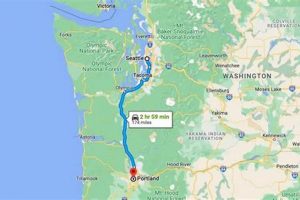The geographical corridor connecting the state’s largest metropolitan area to a significant city in Eastern Oregon represents a vital thoroughfare. This route facilitates the movement of goods, services, and people, linking the economic and cultural hubs of the western and eastern regions of the state.
This connection has several key benefits. It supports commerce by enabling efficient transportation of agricultural products from Eastern Oregon to markets in the west and beyond. Conversely, it allows for the distribution of manufactured goods and services from the Portland area to Eastern Oregon communities. Historically, this pathway has been crucial for settlement and development, shaping the cultural and economic landscape of Oregon.
The subsequent discussion will explore travel options between these two locations, highlighting considerations such as distance, transportation methods, and points of interest along the way. This examination aims to provide a comprehensive understanding of the journey and its significance.
Guidance for Travel
Considerations for planning a route between Oregon’s western and eastern regions require careful attention to several factors to ensure a smooth and efficient journey.
Tip 1: Route Selection: Interstate 84 is the primary and most direct route. Alternative routes may offer scenic views but typically add significant travel time and can be affected by seasonal weather conditions.
Tip 2: Travel Time Allocation: A typical drive requires approximately four to five hours, contingent on traffic conditions, especially near the Portland metropolitan area, and weather patterns, particularly during winter months in the Columbia River Gorge.
Tip 3: Fuel Planning: Ensure adequate fuel levels before departure, as fuel stations may be limited in certain stretches of the route, especially east of The Dalles. Plan fuel stops accordingly.
Tip 4: Weather Monitoring: Check weather forecasts and road conditions prior to and during travel. The Columbia River Gorge is known for its variable weather, including high winds and ice during winter.
Tip 5: Rest Stops: Utilize available rest areas along I-84 for breaks. These facilities provide opportunities for stretching, restroom use, and general respite from driving.
Tip 6: Accommodation Considerations: If the journey extends beyond a single day, pre-book accommodations in cities along the route such as The Dalles, Hermiston, or Pendleton. This secures lodging, particularly during peak travel seasons.
Tip 7: Vehicle Maintenance: Confirm the vehicle is in optimal condition. Check tire pressure, fluid levels, and overall mechanical readiness before undertaking the trip to mitigate potential roadside issues.
Adhering to these recommendations enhances the safety and efficiency of travel, allowing for a more predictable and comfortable experience. The information presented serves as a foundation for further discussion about specific attractions and destinations along the corridor.
Subsequent sections will delve into points of interest and potential detours along the way, offering options for those seeking to enrich their travel experience.
1. Distance
The geographical separation between Portland, Oregon, and Pendleton, Oregon, is a fundamental factor influencing travel, commerce, and communication between these regions. The extent of this separation dictates logistical considerations and impacts the efficiency of various activities.
- Driving Mileage
The most direct driving route, primarily via Interstate 84, spans approximately 210 miles. This measurement is the baseline for calculating travel time and fuel consumption, directly affecting transportation costs and planning.
- Perception of Remoteness
The physical distance contributes to a perception of remoteness, potentially influencing business decisions, tourism patterns, and access to specialized services. This perceived distance shapes interactions between the urban center of Portland and the more rural character of Pendleton and surrounding areas.
- Impact on Supply Chains
Distance plays a crucial role in supply chain management. The cost and time required to transport goods between the two locations affect pricing and availability of products, impacting both local economies.
- Influence on Communication Frequency
While modern technology mitigates some effects of distance, the physical separation can still influence the frequency and nature of personal and professional communications. The need for in-person meetings or site visits is weighed against the cost and time involved in traversing the distance.
In summary, the distance between Portland and Pendleton is not merely a static measurement. It is a dynamic factor that shapes economic, social, and logistical interactions between the two regions. Understanding the implications of this distance is essential for effective planning and resource allocation.
2. Interstate 84
Interstate 84 (I-84) is the primary transportation artery facilitating movement between Portland, Oregon, and Pendleton, Oregon. Its role is essential in connecting the western and eastern parts of the state, influencing commerce, travel, and regional development.
- Primary Route for Travel
I-84 provides the most direct and efficient route for vehicular traffic. Alternative routes exist, but they generally add considerable time to the journey. This makes I-84 the preferred choice for both passenger and commercial vehicles traveling between the two cities.
- Economic Conduit
The interstate serves as a critical conduit for transporting goods and services. Agricultural products from Eastern Oregon and manufactured goods from the Portland metropolitan area rely on I-84 for distribution. This flow of commerce is vital for the economic health of both regions.
- Influence on Regional Accessibility
I-84’s presence significantly improves accessibility to smaller communities located along its path. Towns such as The Dalles, Hood River, and Hermiston benefit from the increased traffic and economic opportunities facilitated by the interstate.
- Susceptibility to Disruptions
Despite its importance, I-84 is susceptible to closures and delays due to adverse weather conditions, particularly in the Columbia River Gorge. Snow, ice, and high winds can disrupt traffic flow and impact travel times, highlighting the need for contingency planning.
In summary, Interstate 84 functions as the backbone of transportation between Portland and Pendleton, shaping economic interactions and regional accessibility. Understanding the interstate’s role and limitations is crucial for efficient planning and management of resources in the region.
3. Travel Time
The duration of transit between Portland, Oregon, and Pendleton, Oregon, is a critical variable influencing travel decisions, logistical planning, and overall regional connectivity. Travel time serves as a practical metric for assessing the efficiency and feasibility of movement along this corridor. Increased travel time, stemming from factors like traffic congestion or adverse weather, directly increases operational costs for freight transport and reduces the attractiveness of the route for individual travelers. For example, a delay of one hour can significantly impact delivery schedules for agricultural products, affecting market prices and availability.
Various factors contribute to variability in travel time. Interstate 84, the primary route, is prone to seasonal weather disturbances, particularly in the Columbia River Gorge, leading to closures or reduced speeds. Construction activities and traffic incidents also introduce unpredictable delays. Efficient route planning incorporates real-time traffic data and weather forecasts to mitigate these uncertainties. Furthermore, the choice of transportation mode personal vehicle versus commercial trucking influences travel time due to differing speed limits and operational requirements.
Effective management of travel time is essential for optimizing the benefits of connectivity between Portland and Pendleton. Investments in infrastructure improvements, such as road maintenance and expansion projects, aim to reduce congestion and improve flow. Public awareness campaigns highlighting safe driving practices during inclement weather help to minimize disruptions. By understanding and actively managing the factors that affect travel time, the efficiency and reliability of transport between these two cities can be significantly enhanced, fostering stronger economic and social ties.
4. Columbia Gorge
The Columbia River Gorge represents a significant geographical feature along the route between Portland, Oregon, and Pendleton, Oregon. Its presence directly impacts travel conditions, logistical planning, and regional connectivity. The Gorge acts as a natural corridor through the Cascade Mountain Range, facilitating the passage of Interstate 84, the primary route connecting the two cities. However, its unique topography and climate introduce challenges that directly affect travel time and safety.
Weather conditions within the Columbia Gorge are often unpredictable and can vary significantly within short distances. High winds, ice storms, and heavy snowfall are common occurrences, particularly during the winter months. These conditions frequently lead to reduced speed limits, road closures, and increased accident risks. The geography of the Gorge, with its steep cliffs and narrow passages, exacerbates these hazards. As a result, transportation between Portland and Pendleton can be significantly disrupted, impacting supply chains and personal travel plans. For instance, commercial trucking, essential for transporting agricultural goods from Eastern Oregon, faces substantial delays during Gorge-related closures. The 2017 Eagle Creek Fire, which caused extensive damage to the Gorge’s ecosystem and infrastructure, exemplifies the potential for significant and prolonged disruptions to transportation.
Effective navigation of the Columbia River Gorge requires careful planning and awareness of potential hazards. Travelers should monitor weather forecasts and road conditions prior to departure and remain vigilant throughout their journey. Understanding the Gorge’s influence on travel is crucial for maintaining efficient and safe transport between Portland and Pendleton, underscoring the need for proactive measures to mitigate potential disruptions. Efforts to improve infrastructure, such as avalanche control systems and enhanced weather monitoring technologies, aim to enhance the reliability of Interstate 84 through this challenging environment.
5. Eastern Oregon
Eastern Oregon represents a crucial component in understanding the significance of travel and transport from Portland to Pendleton. It is the destination and origin point for much of the traffic along that route. The economies of communities in Eastern Oregon, including Pendleton, are intrinsically linked to their ability to access markets and services in the Portland metropolitan area. Agricultural products, such as wheat, hay, and livestock, originating from Eastern Oregon farms and ranches, rely on efficient transportation to reach processing facilities, distribution centers, and ultimately, consumers in Portland and beyond. Conversely, manufactured goods, equipment, and specialized services from Portland are essential for supporting economic activity and quality of life in Eastern Oregon. The route acts as a lifeline, ensuring the sustenance and development of these communities.
Without reliable transportation corridors, Eastern Oregon’s economic vitality would be significantly diminished. Consider the impact on Pendleton’s annual Round-Up, a major cultural event and economic driver for the region. Efficient transportation is essential for bringing visitors, participants, and supplies to the event. Similarly, healthcare access for residents of Eastern Oregon often depends on their ability to reach specialists and medical facilities located in Portland. The geographical distance and challenging terrain emphasize the importance of well-maintained roads and transportation infrastructure. Delays or disruptions along the route can have serious consequences, affecting everything from timely delivery of agricultural products to access to essential medical care.
In conclusion, the relationship between Eastern Oregon and the Portland-Pendleton corridor is symbiotic. Eastern Oregon’s economic health and social well-being are heavily dependent on reliable access to the resources and markets available in the west. Understanding this connection is essential for policymakers, transportation planners, and businesses alike. Ensuring the continued functionality and efficiency of the route is vital for the sustainability and prosperity of both regions, addressing unique challenges specific to rural transport such as limited infrastructure and seasonal impacts.
6. Transportation
The viability of the Portland, Oregon, to Pendleton, Oregon, connection hinges fundamentally on efficient and reliable transportation systems. This reliance stems from the geographical separation of the two cities, necessitating robust infrastructure to facilitate the movement of goods, services, and individuals. Without adequate transportation, economic exchange and social interaction would be severely limited. For instance, the agricultural sector in Eastern Oregon depends on trucking services to transport crops to markets in the Portland area and beyond. Conversely, Portland-based industries rely on efficient transport to distribute manufactured goods and provide services to the eastern part of the state.
The primary mode of transport along this route is via Interstate 84, which serves as the economic lifeline connecting the two regions. Disruptions to this transportation artery, such as those caused by weather-related closures or infrastructure failures, can have significant consequences. For example, a winter storm closing the highway can lead to delays in the delivery of essential supplies, impacting businesses and residents alike. The Columbia River Gorge, a particularly challenging section of the route, requires specialized transportation management strategies to mitigate risks associated with high winds, icy conditions, and potential rockslides. Furthermore, alternative transportation options, such as rail and air services, play a supplementary role in supporting the overall transportation network. However, their capacity and reach are generally limited compared to highway transport.
In summary, transportation is not merely a logistical detail but a critical determinant of the relationship between Portland and Pendleton. The efficiency and reliability of transportation infrastructure directly impact the economic vitality and social connectivity of both regions. Future investments in transportation improvements, including road maintenance, capacity expansion, and the development of alternative transportation modes, are essential for ensuring the continued prosperity of both communities and mitigating the risks associated with disruptions to this vital link.
Frequently Asked Questions
This section addresses common inquiries regarding travel and transport between Portland and Pendleton, Oregon, providing concise and factual answers.
Question 1: What is the most direct route between Portland and Pendleton?
The most direct route is via Interstate 84, traversing eastward from Portland to Pendleton. This route is generally the fastest and most efficient for both passenger and commercial vehicles.
Question 2: How long does it typically take to drive from Portland to Pendleton?
Typical driving time ranges from four to five hours, depending on traffic conditions, weather, and the specific point of origin in Portland and destination in Pendleton.
Question 3: Are there alternative routes to Interstate 84?
Alternative routes exist, but they generally add significant time and complexity to the journey. These may include state highways and county roads, often less maintained and subject to more challenging driving conditions.
Question 4: What are the primary factors that can affect travel time?
Key factors impacting travel time include traffic congestion, particularly in the Portland metropolitan area and the Columbia River Gorge, adverse weather conditions (especially during winter), and construction activity.
Question 5: Are there rest areas or services available along Interstate 84?
Yes, several rest areas and service plazas are located along I-84, providing opportunities for rest, fuel, and refreshments. These facilities are typically well-maintained and offer essential amenities for travelers.
Question 6: What precautions should be taken when traveling through the Columbia River Gorge?
Travelers should monitor weather forecasts and road conditions closely, particularly during periods of high winds, ice, or snow. It is advisable to carry emergency supplies and be prepared for potential delays or closures.
In summary, travel between Portland and Pendleton requires careful planning and awareness of potential challenges. Understanding the route, potential delays, and available resources is essential for a safe and efficient journey.
The subsequent section will delve into safety and emergency considerations for this route.
Portland Oregon to Pendleton Oregon
The preceding analysis has elucidated the multifaceted relationship between Portland and Pendleton. It has underscored the geographical distance, the pivotal role of Interstate 84, the variable travel times, the environmental challenges posed by the Columbia River Gorge, and the vital economic link to Eastern Oregon. A comprehensive understanding of these elements is essential for informed decision-making related to transportation, logistics, and regional development.
The continued efficiency and reliability of the corridor connecting Portland Oregon to Pendleton Oregon is paramount. Sustained investment in infrastructure, proactive planning for potential disruptions, and a commitment to safety are necessary to ensure the enduring prosperity of both communities. Vigilance and informed action are crucial for navigating the complexities of this important route.







